Reflective Case Study: Analysing Effective Team Components in MNG82001
VerifiedAdded on 2023/03/20
|8
|1926
|35
Case Study
AI Summary
This case study analyzes the key components of an effective team, based on the student's personal workplace experience as a team leader. The student identifies challenges such as lack of communication, leadership issues, and cultural differences within the team. The case explores techniques to resolve these issues, emphasizing the importance of open communication, transparency, and the consideration of team members' strengths and weaknesses. The student applies Tuckman's Team Development Theory, detailing how each stage (Forming, Storming, Norming, Performing, and Adjourning) was used to improve team dynamics and achieve goals. The study concludes with learning outcomes highlighting the significance of teamwork, communication, and conflict resolution. The assignment also includes questions and example answers to further analyze the case and demonstrate potential learning outcomes. The student uses multiple academic journal references to support the analysis.
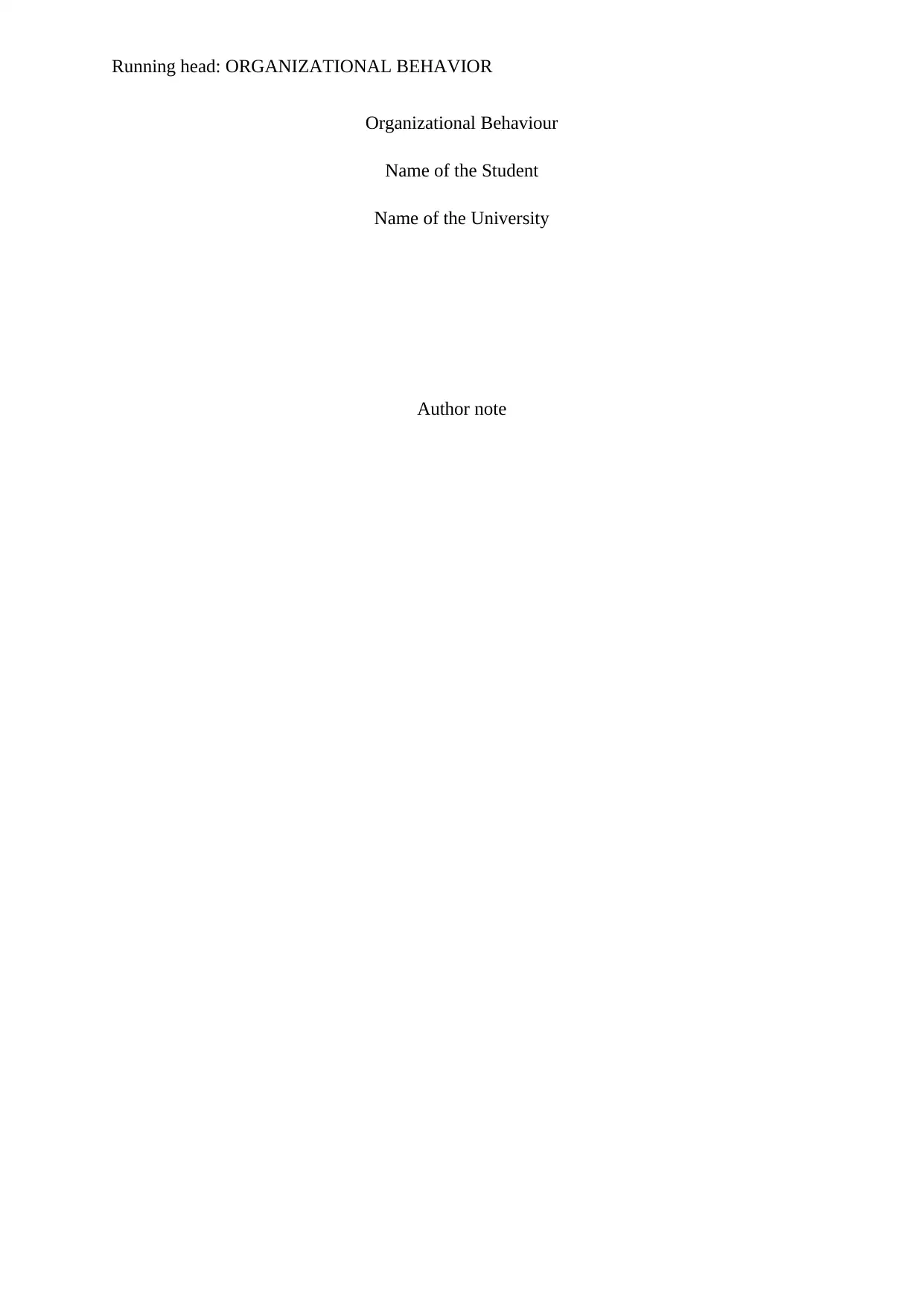
Running head: ORGANIZATIONAL BEHAVIOR
Organizational Behaviour
Name of the Student
Name of the University
Author note
Organizational Behaviour
Name of the Student
Name of the University
Author note
Paraphrase This Document
Need a fresh take? Get an instant paraphrase of this document with our AI Paraphraser
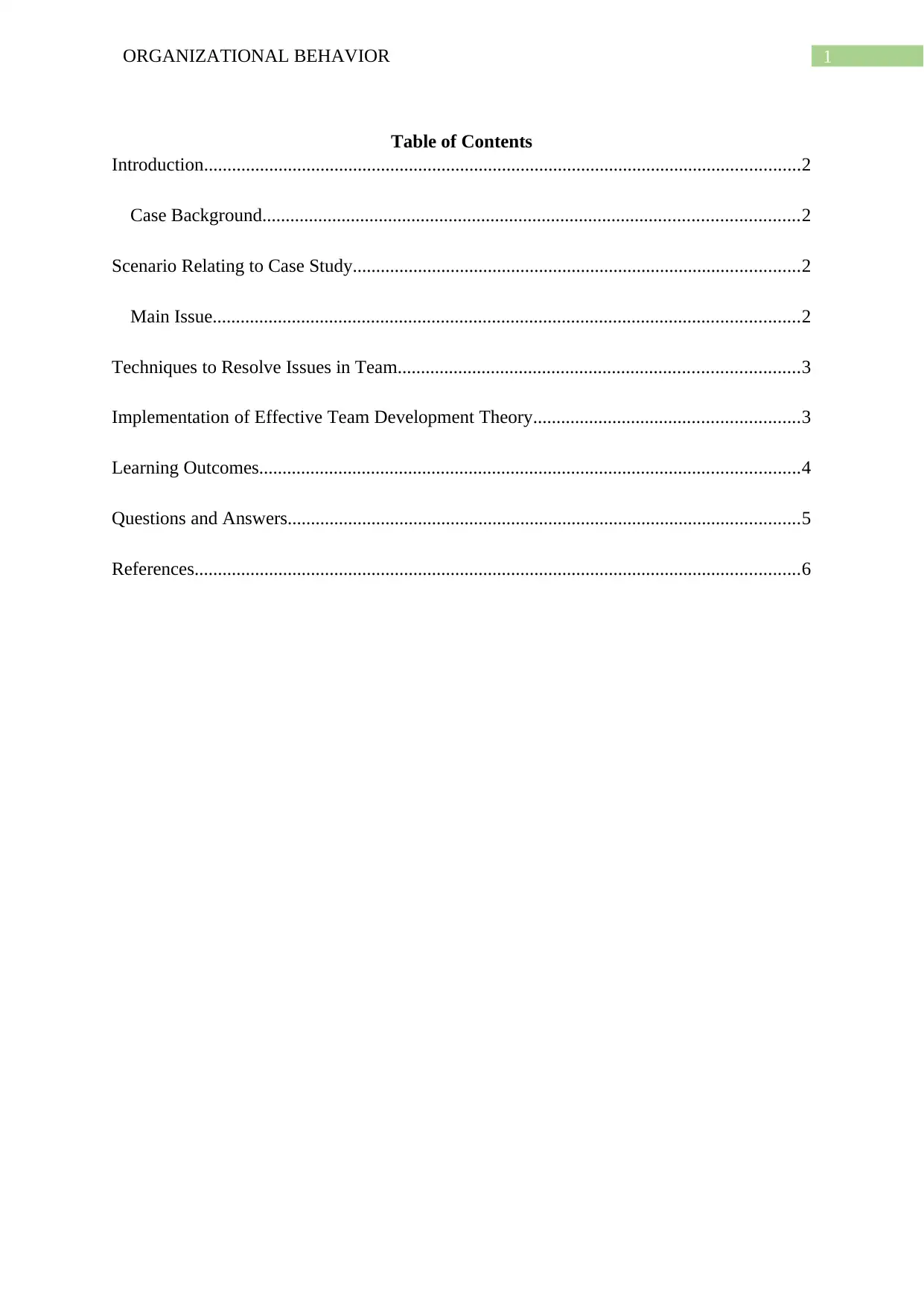
1ORGANIZATIONAL BEHAVIOR
Table of Contents
Introduction................................................................................................................................2
Case Background...................................................................................................................2
Scenario Relating to Case Study................................................................................................2
Main Issue..............................................................................................................................2
Techniques to Resolve Issues in Team......................................................................................3
Implementation of Effective Team Development Theory.........................................................3
Learning Outcomes....................................................................................................................4
Questions and Answers..............................................................................................................5
References..................................................................................................................................6
Table of Contents
Introduction................................................................................................................................2
Case Background...................................................................................................................2
Scenario Relating to Case Study................................................................................................2
Main Issue..............................................................................................................................2
Techniques to Resolve Issues in Team......................................................................................3
Implementation of Effective Team Development Theory.........................................................3
Learning Outcomes....................................................................................................................4
Questions and Answers..............................................................................................................5
References..................................................................................................................................6
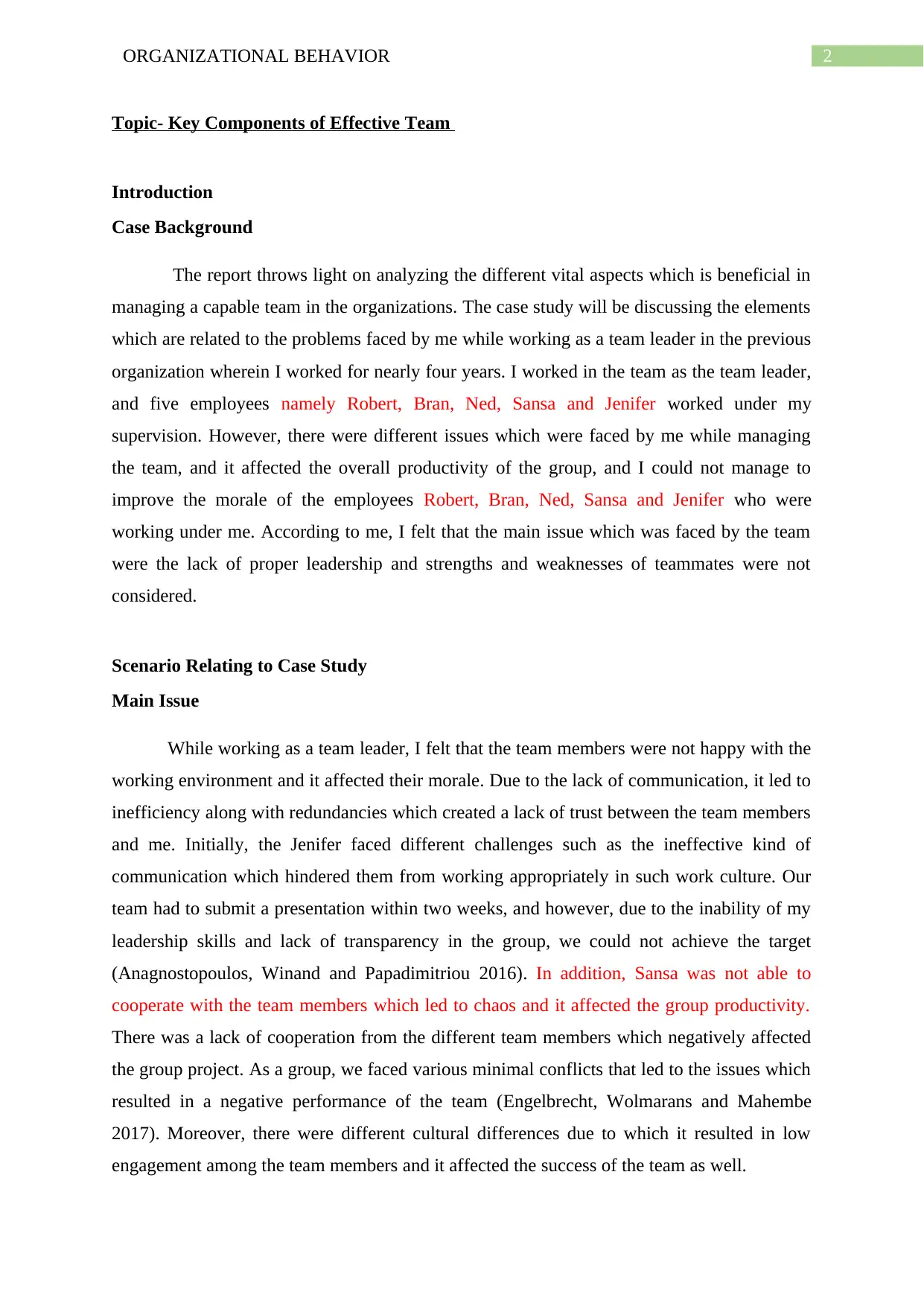
2ORGANIZATIONAL BEHAVIOR
Topic- Key Components of Effective Team
Introduction
Case Background
The report throws light on analyzing the different vital aspects which is beneficial in
managing a capable team in the organizations. The case study will be discussing the elements
which are related to the problems faced by me while working as a team leader in the previous
organization wherein I worked for nearly four years. I worked in the team as the team leader,
and five employees namely Robert, Bran, Ned, Sansa and Jenifer worked under my
supervision. However, there were different issues which were faced by me while managing
the team, and it affected the overall productivity of the group, and I could not manage to
improve the morale of the employees Robert, Bran, Ned, Sansa and Jenifer who were
working under me. According to me, I felt that the main issue which was faced by the team
were the lack of proper leadership and strengths and weaknesses of teammates were not
considered.
Scenario Relating to Case Study
Main Issue
While working as a team leader, I felt that the team members were not happy with the
working environment and it affected their morale. Due to the lack of communication, it led to
inefficiency along with redundancies which created a lack of trust between the team members
and me. Initially, the Jenifer faced different challenges such as the ineffective kind of
communication which hindered them from working appropriately in such work culture. Our
team had to submit a presentation within two weeks, and however, due to the inability of my
leadership skills and lack of transparency in the group, we could not achieve the target
(Anagnostopoulos, Winand and Papadimitriou 2016). In addition, Sansa was not able to
cooperate with the team members which led to chaos and it affected the group productivity.
There was a lack of cooperation from the different team members which negatively affected
the group project. As a group, we faced various minimal conflicts that led to the issues which
resulted in a negative performance of the team (Engelbrecht, Wolmarans and Mahembe
2017). Moreover, there were different cultural differences due to which it resulted in low
engagement among the team members and it affected the success of the team as well.
Topic- Key Components of Effective Team
Introduction
Case Background
The report throws light on analyzing the different vital aspects which is beneficial in
managing a capable team in the organizations. The case study will be discussing the elements
which are related to the problems faced by me while working as a team leader in the previous
organization wherein I worked for nearly four years. I worked in the team as the team leader,
and five employees namely Robert, Bran, Ned, Sansa and Jenifer worked under my
supervision. However, there were different issues which were faced by me while managing
the team, and it affected the overall productivity of the group, and I could not manage to
improve the morale of the employees Robert, Bran, Ned, Sansa and Jenifer who were
working under me. According to me, I felt that the main issue which was faced by the team
were the lack of proper leadership and strengths and weaknesses of teammates were not
considered.
Scenario Relating to Case Study
Main Issue
While working as a team leader, I felt that the team members were not happy with the
working environment and it affected their morale. Due to the lack of communication, it led to
inefficiency along with redundancies which created a lack of trust between the team members
and me. Initially, the Jenifer faced different challenges such as the ineffective kind of
communication which hindered them from working appropriately in such work culture. Our
team had to submit a presentation within two weeks, and however, due to the inability of my
leadership skills and lack of transparency in the group, we could not achieve the target
(Anagnostopoulos, Winand and Papadimitriou 2016). In addition, Sansa was not able to
cooperate with the team members which led to chaos and it affected the group productivity.
There was a lack of cooperation from the different team members which negatively affected
the group project. As a group, we faced various minimal conflicts that led to the issues which
resulted in a negative performance of the team (Engelbrecht, Wolmarans and Mahembe
2017). Moreover, there were different cultural differences due to which it resulted in low
engagement among the team members and it affected the success of the team as well.
⊘ This is a preview!⊘
Do you want full access?
Subscribe today to unlock all pages.

Trusted by 1+ million students worldwide
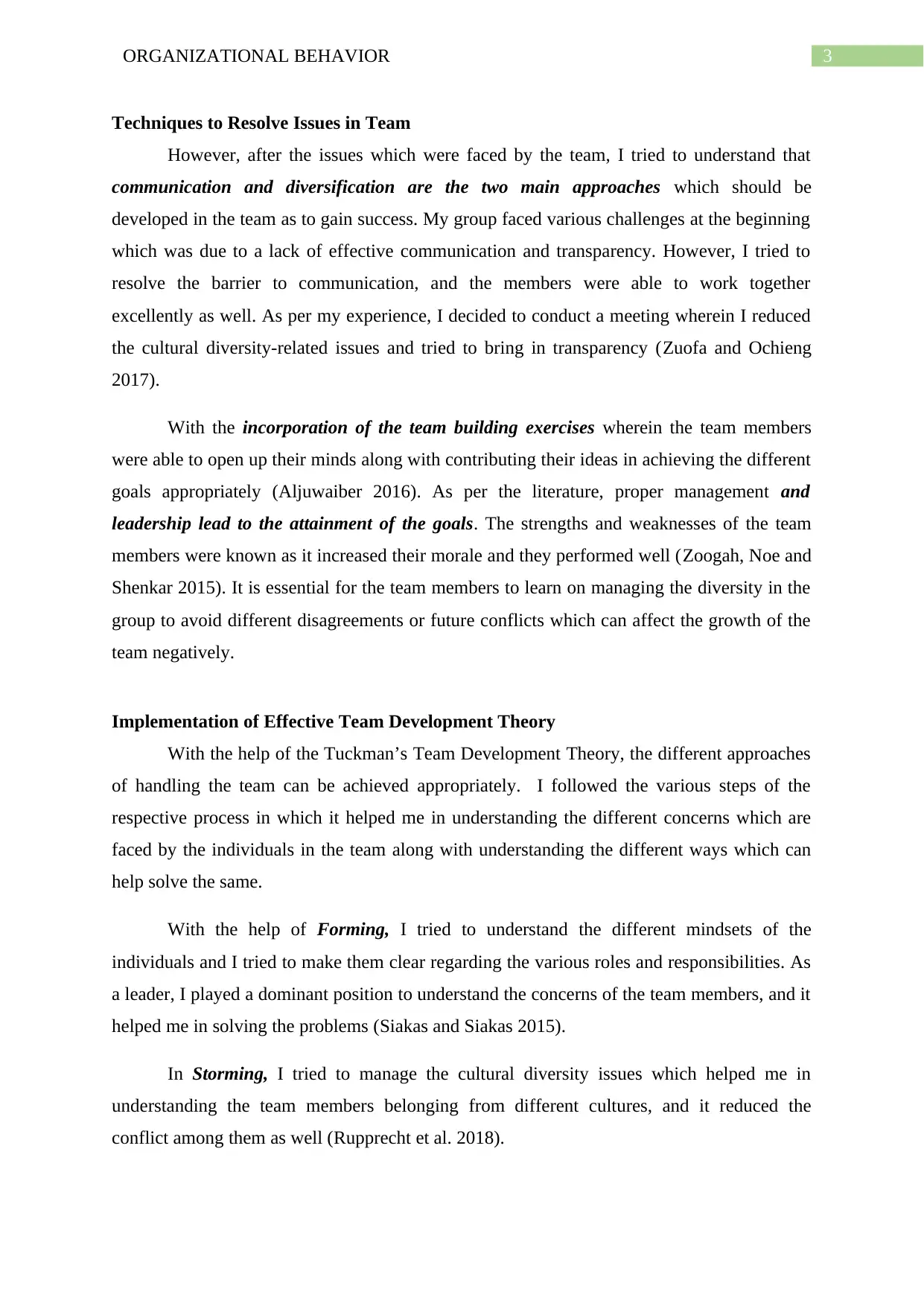
3ORGANIZATIONAL BEHAVIOR
Techniques to Resolve Issues in Team
However, after the issues which were faced by the team, I tried to understand that
communication and diversification are the two main approaches which should be
developed in the team as to gain success. My group faced various challenges at the beginning
which was due to a lack of effective communication and transparency. However, I tried to
resolve the barrier to communication, and the members were able to work together
excellently as well. As per my experience, I decided to conduct a meeting wherein I reduced
the cultural diversity-related issues and tried to bring in transparency (Zuofa and Ochieng
2017).
With the incorporation of the team building exercises wherein the team members
were able to open up their minds along with contributing their ideas in achieving the different
goals appropriately (Aljuwaiber 2016). As per the literature, proper management and
leadership lead to the attainment of the goals. The strengths and weaknesses of the team
members were known as it increased their morale and they performed well (Zoogah, Noe and
Shenkar 2015). It is essential for the team members to learn on managing the diversity in the
group to avoid different disagreements or future conflicts which can affect the growth of the
team negatively.
Implementation of Effective Team Development Theory
With the help of the Tuckman’s Team Development Theory, the different approaches
of handling the team can be achieved appropriately. I followed the various steps of the
respective process in which it helped me in understanding the different concerns which are
faced by the individuals in the team along with understanding the different ways which can
help solve the same.
With the help of Forming, I tried to understand the different mindsets of the
individuals and I tried to make them clear regarding the various roles and responsibilities. As
a leader, I played a dominant position to understand the concerns of the team members, and it
helped me in solving the problems (Siakas and Siakas 2015).
In Storming, I tried to manage the cultural diversity issues which helped me in
understanding the team members belonging from different cultures, and it reduced the
conflict among them as well (Rupprecht et al. 2018).
Techniques to Resolve Issues in Team
However, after the issues which were faced by the team, I tried to understand that
communication and diversification are the two main approaches which should be
developed in the team as to gain success. My group faced various challenges at the beginning
which was due to a lack of effective communication and transparency. However, I tried to
resolve the barrier to communication, and the members were able to work together
excellently as well. As per my experience, I decided to conduct a meeting wherein I reduced
the cultural diversity-related issues and tried to bring in transparency (Zuofa and Ochieng
2017).
With the incorporation of the team building exercises wherein the team members
were able to open up their minds along with contributing their ideas in achieving the different
goals appropriately (Aljuwaiber 2016). As per the literature, proper management and
leadership lead to the attainment of the goals. The strengths and weaknesses of the team
members were known as it increased their morale and they performed well (Zoogah, Noe and
Shenkar 2015). It is essential for the team members to learn on managing the diversity in the
group to avoid different disagreements or future conflicts which can affect the growth of the
team negatively.
Implementation of Effective Team Development Theory
With the help of the Tuckman’s Team Development Theory, the different approaches
of handling the team can be achieved appropriately. I followed the various steps of the
respective process in which it helped me in understanding the different concerns which are
faced by the individuals in the team along with understanding the different ways which can
help solve the same.
With the help of Forming, I tried to understand the different mindsets of the
individuals and I tried to make them clear regarding the various roles and responsibilities. As
a leader, I played a dominant position to understand the concerns of the team members, and it
helped me in solving the problems (Siakas and Siakas 2015).
In Storming, I tried to manage the cultural diversity issues which helped me in
understanding the team members belonging from different cultures, and it reduced the
conflict among them as well (Rupprecht et al. 2018).
Paraphrase This Document
Need a fresh take? Get an instant paraphrase of this document with our AI Paraphraser
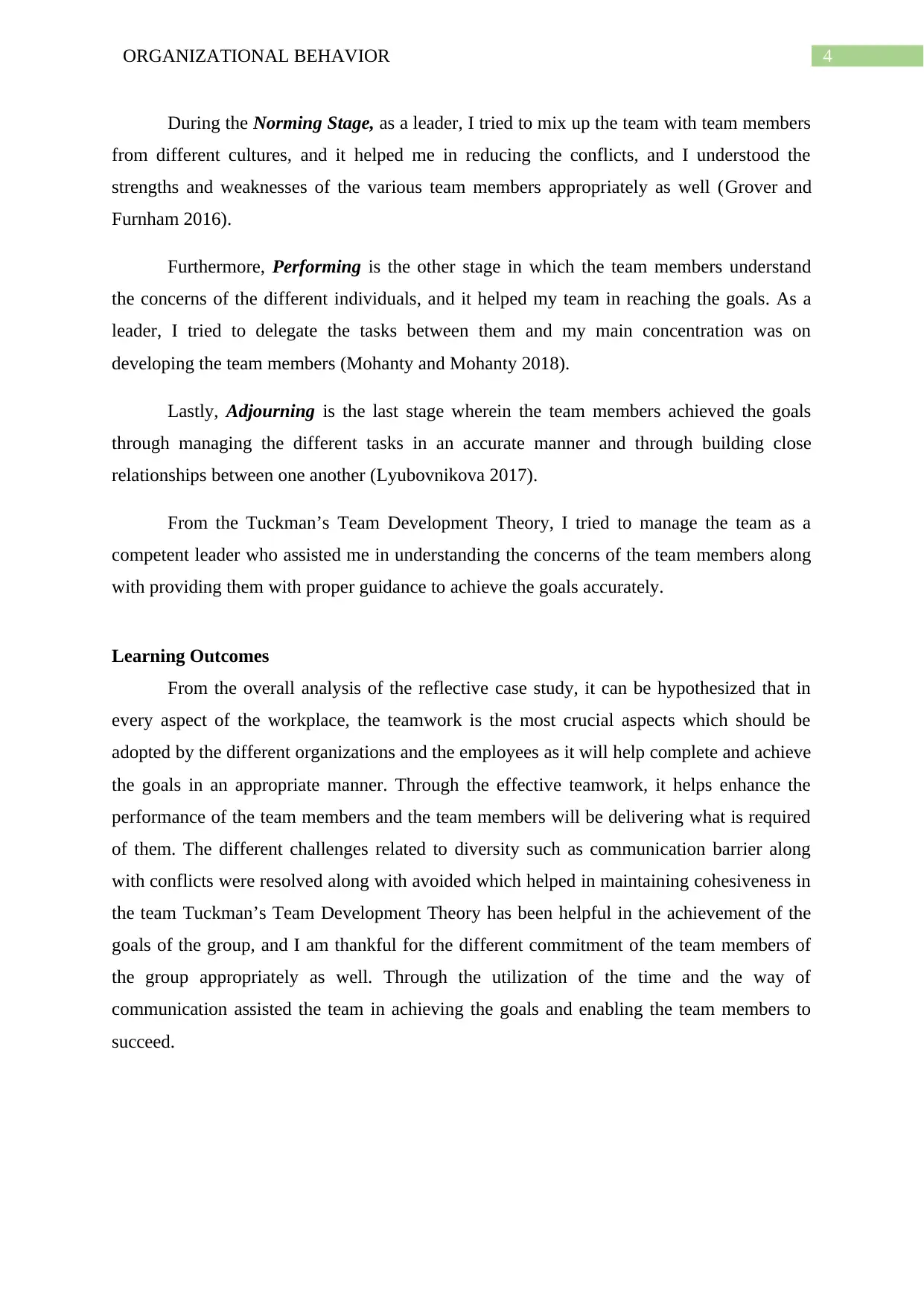
4ORGANIZATIONAL BEHAVIOR
During the Norming Stage, as a leader, I tried to mix up the team with team members
from different cultures, and it helped me in reducing the conflicts, and I understood the
strengths and weaknesses of the various team members appropriately as well (Grover and
Furnham 2016).
Furthermore, Performing is the other stage in which the team members understand
the concerns of the different individuals, and it helped my team in reaching the goals. As a
leader, I tried to delegate the tasks between them and my main concentration was on
developing the team members (Mohanty and Mohanty 2018).
Lastly, Adjourning is the last stage wherein the team members achieved the goals
through managing the different tasks in an accurate manner and through building close
relationships between one another (Lyubovnikova 2017).
From the Tuckman’s Team Development Theory, I tried to manage the team as a
competent leader who assisted me in understanding the concerns of the team members along
with providing them with proper guidance to achieve the goals accurately.
Learning Outcomes
From the overall analysis of the reflective case study, it can be hypothesized that in
every aspect of the workplace, the teamwork is the most crucial aspects which should be
adopted by the different organizations and the employees as it will help complete and achieve
the goals in an appropriate manner. Through the effective teamwork, it helps enhance the
performance of the team members and the team members will be delivering what is required
of them. The different challenges related to diversity such as communication barrier along
with conflicts were resolved along with avoided which helped in maintaining cohesiveness in
the team Tuckman’s Team Development Theory has been helpful in the achievement of the
goals of the group, and I am thankful for the different commitment of the team members of
the group appropriately as well. Through the utilization of the time and the way of
communication assisted the team in achieving the goals and enabling the team members to
succeed.
During the Norming Stage, as a leader, I tried to mix up the team with team members
from different cultures, and it helped me in reducing the conflicts, and I understood the
strengths and weaknesses of the various team members appropriately as well (Grover and
Furnham 2016).
Furthermore, Performing is the other stage in which the team members understand
the concerns of the different individuals, and it helped my team in reaching the goals. As a
leader, I tried to delegate the tasks between them and my main concentration was on
developing the team members (Mohanty and Mohanty 2018).
Lastly, Adjourning is the last stage wherein the team members achieved the goals
through managing the different tasks in an accurate manner and through building close
relationships between one another (Lyubovnikova 2017).
From the Tuckman’s Team Development Theory, I tried to manage the team as a
competent leader who assisted me in understanding the concerns of the team members along
with providing them with proper guidance to achieve the goals accurately.
Learning Outcomes
From the overall analysis of the reflective case study, it can be hypothesized that in
every aspect of the workplace, the teamwork is the most crucial aspects which should be
adopted by the different organizations and the employees as it will help complete and achieve
the goals in an appropriate manner. Through the effective teamwork, it helps enhance the
performance of the team members and the team members will be delivering what is required
of them. The different challenges related to diversity such as communication barrier along
with conflicts were resolved along with avoided which helped in maintaining cohesiveness in
the team Tuckman’s Team Development Theory has been helpful in the achievement of the
goals of the group, and I am thankful for the different commitment of the team members of
the group appropriately as well. Through the utilization of the time and the way of
communication assisted the team in achieving the goals and enabling the team members to
succeed.
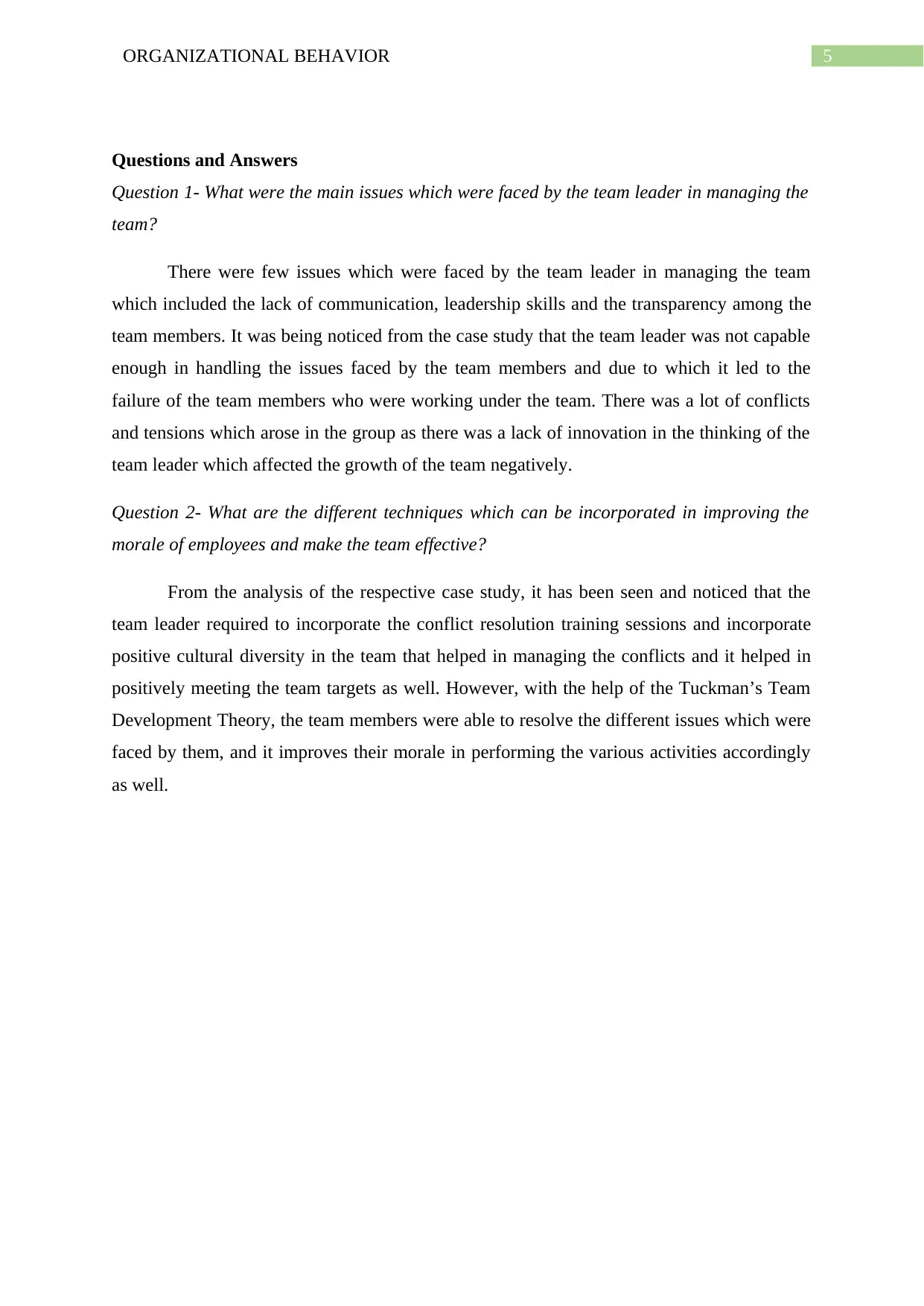
5ORGANIZATIONAL BEHAVIOR
Questions and Answers
Question 1- What were the main issues which were faced by the team leader in managing the
team?
There were few issues which were faced by the team leader in managing the team
which included the lack of communication, leadership skills and the transparency among the
team members. It was being noticed from the case study that the team leader was not capable
enough in handling the issues faced by the team members and due to which it led to the
failure of the team members who were working under the team. There was a lot of conflicts
and tensions which arose in the group as there was a lack of innovation in the thinking of the
team leader which affected the growth of the team negatively.
Question 2- What are the different techniques which can be incorporated in improving the
morale of employees and make the team effective?
From the analysis of the respective case study, it has been seen and noticed that the
team leader required to incorporate the conflict resolution training sessions and incorporate
positive cultural diversity in the team that helped in managing the conflicts and it helped in
positively meeting the team targets as well. However, with the help of the Tuckman’s Team
Development Theory, the team members were able to resolve the different issues which were
faced by them, and it improves their morale in performing the various activities accordingly
as well.
Questions and Answers
Question 1- What were the main issues which were faced by the team leader in managing the
team?
There were few issues which were faced by the team leader in managing the team
which included the lack of communication, leadership skills and the transparency among the
team members. It was being noticed from the case study that the team leader was not capable
enough in handling the issues faced by the team members and due to which it led to the
failure of the team members who were working under the team. There was a lot of conflicts
and tensions which arose in the group as there was a lack of innovation in the thinking of the
team leader which affected the growth of the team negatively.
Question 2- What are the different techniques which can be incorporated in improving the
morale of employees and make the team effective?
From the analysis of the respective case study, it has been seen and noticed that the
team leader required to incorporate the conflict resolution training sessions and incorporate
positive cultural diversity in the team that helped in managing the conflicts and it helped in
positively meeting the team targets as well. However, with the help of the Tuckman’s Team
Development Theory, the team members were able to resolve the different issues which were
faced by them, and it improves their morale in performing the various activities accordingly
as well.
⊘ This is a preview!⊘
Do you want full access?
Subscribe today to unlock all pages.

Trusted by 1+ million students worldwide
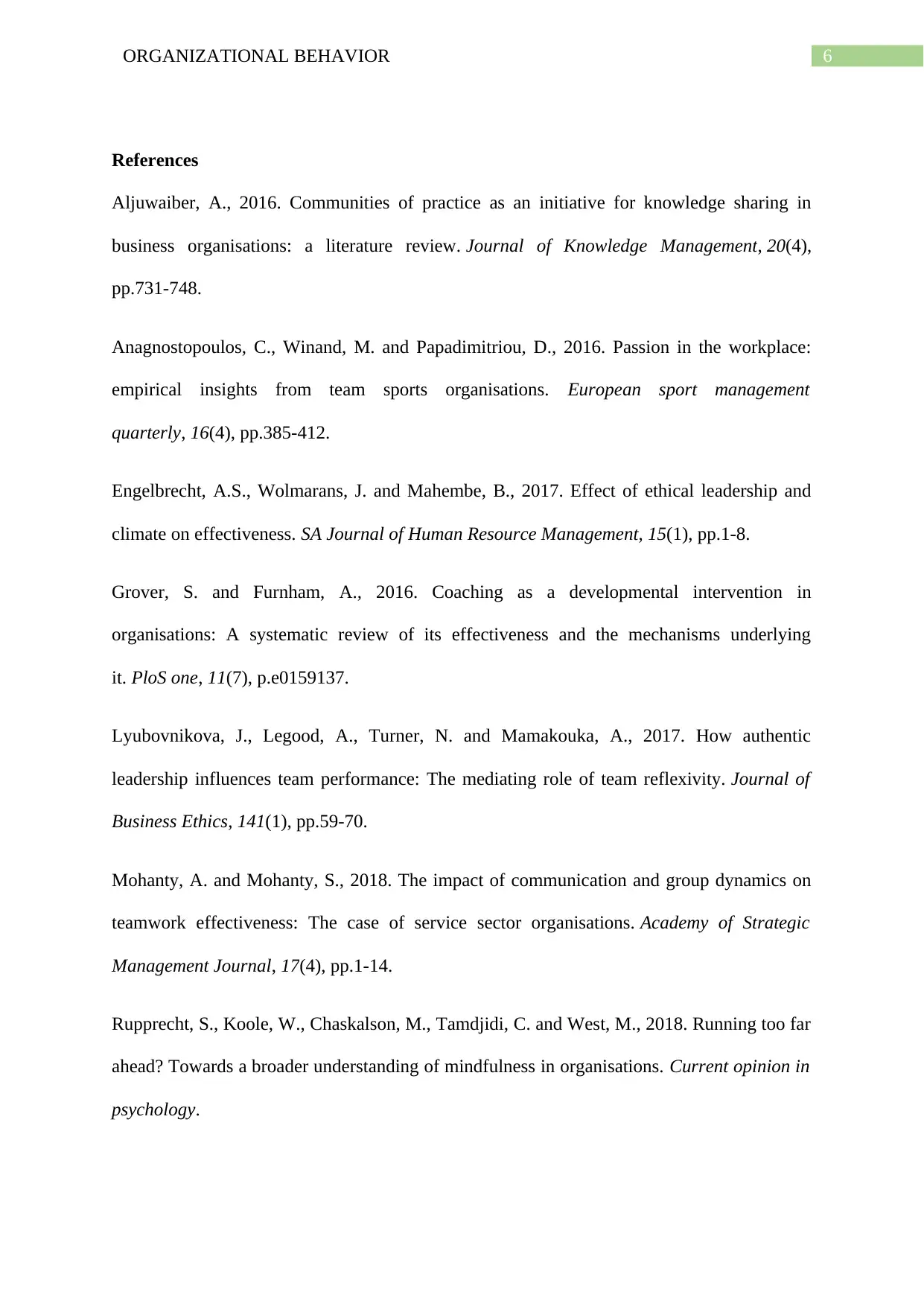
6ORGANIZATIONAL BEHAVIOR
References
Aljuwaiber, A., 2016. Communities of practice as an initiative for knowledge sharing in
business organisations: a literature review. Journal of Knowledge Management, 20(4),
pp.731-748.
Anagnostopoulos, C., Winand, M. and Papadimitriou, D., 2016. Passion in the workplace:
empirical insights from team sports organisations. European sport management
quarterly, 16(4), pp.385-412.
Engelbrecht, A.S., Wolmarans, J. and Mahembe, B., 2017. Effect of ethical leadership and
climate on effectiveness. SA Journal of Human Resource Management, 15(1), pp.1-8.
Grover, S. and Furnham, A., 2016. Coaching as a developmental intervention in
organisations: A systematic review of its effectiveness and the mechanisms underlying
it. PloS one, 11(7), p.e0159137.
Lyubovnikova, J., Legood, A., Turner, N. and Mamakouka, A., 2017. How authentic
leadership influences team performance: The mediating role of team reflexivity. Journal of
Business Ethics, 141(1), pp.59-70.
Mohanty, A. and Mohanty, S., 2018. The impact of communication and group dynamics on
teamwork effectiveness: The case of service sector organisations. Academy of Strategic
Management Journal, 17(4), pp.1-14.
Rupprecht, S., Koole, W., Chaskalson, M., Tamdjidi, C. and West, M., 2018. Running too far
ahead? Towards a broader understanding of mindfulness in organisations. Current opinion in
psychology.
References
Aljuwaiber, A., 2016. Communities of practice as an initiative for knowledge sharing in
business organisations: a literature review. Journal of Knowledge Management, 20(4),
pp.731-748.
Anagnostopoulos, C., Winand, M. and Papadimitriou, D., 2016. Passion in the workplace:
empirical insights from team sports organisations. European sport management
quarterly, 16(4), pp.385-412.
Engelbrecht, A.S., Wolmarans, J. and Mahembe, B., 2017. Effect of ethical leadership and
climate on effectiveness. SA Journal of Human Resource Management, 15(1), pp.1-8.
Grover, S. and Furnham, A., 2016. Coaching as a developmental intervention in
organisations: A systematic review of its effectiveness and the mechanisms underlying
it. PloS one, 11(7), p.e0159137.
Lyubovnikova, J., Legood, A., Turner, N. and Mamakouka, A., 2017. How authentic
leadership influences team performance: The mediating role of team reflexivity. Journal of
Business Ethics, 141(1), pp.59-70.
Mohanty, A. and Mohanty, S., 2018. The impact of communication and group dynamics on
teamwork effectiveness: The case of service sector organisations. Academy of Strategic
Management Journal, 17(4), pp.1-14.
Rupprecht, S., Koole, W., Chaskalson, M., Tamdjidi, C. and West, M., 2018. Running too far
ahead? Towards a broader understanding of mindfulness in organisations. Current opinion in
psychology.
Paraphrase This Document
Need a fresh take? Get an instant paraphrase of this document with our AI Paraphraser
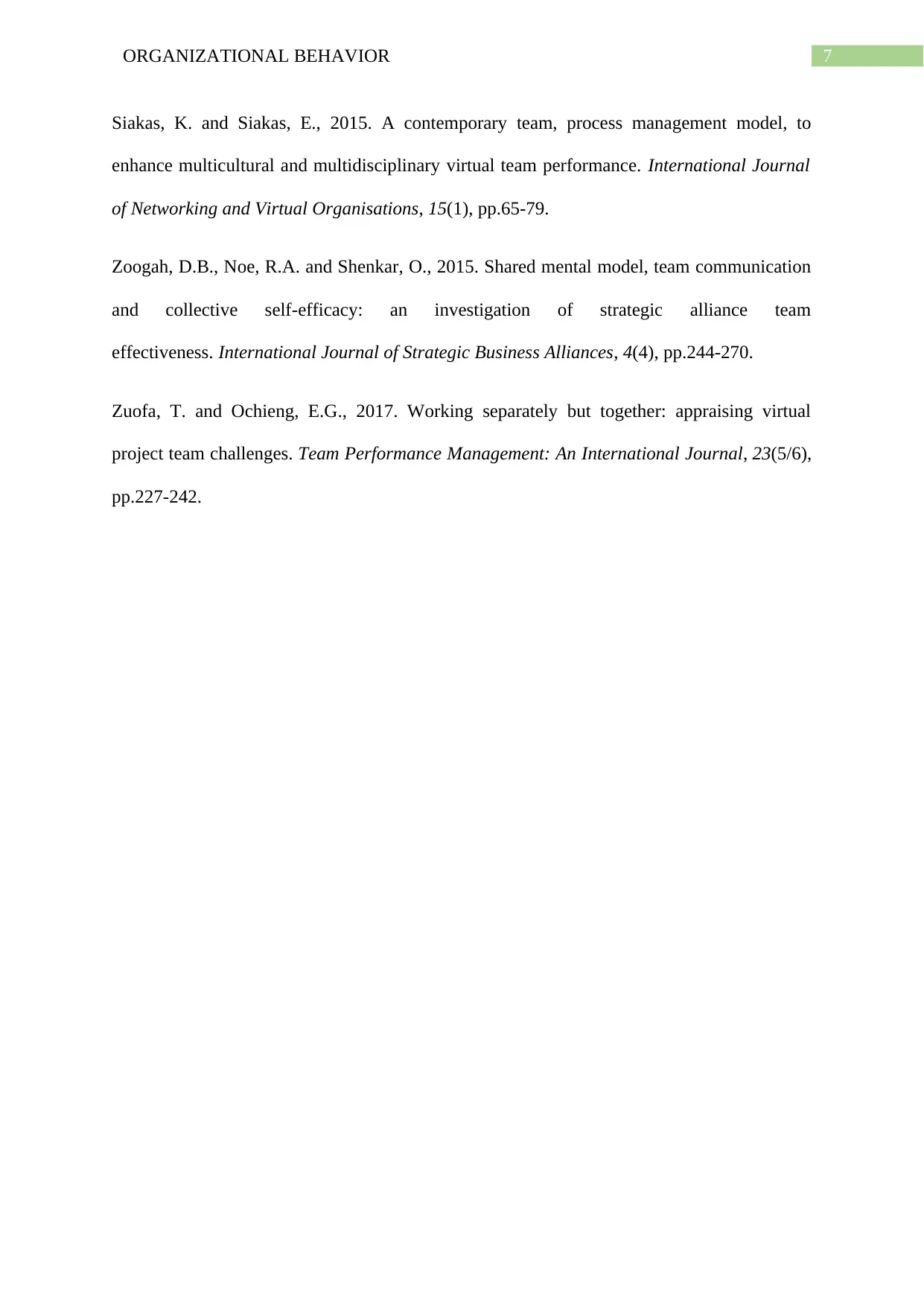
7ORGANIZATIONAL BEHAVIOR
Siakas, K. and Siakas, E., 2015. A contemporary team, process management model, to
enhance multicultural and multidisciplinary virtual team performance. International Journal
of Networking and Virtual Organisations, 15(1), pp.65-79.
Zoogah, D.B., Noe, R.A. and Shenkar, O., 2015. Shared mental model, team communication
and collective self-efficacy: an investigation of strategic alliance team
effectiveness. International Journal of Strategic Business Alliances, 4(4), pp.244-270.
Zuofa, T. and Ochieng, E.G., 2017. Working separately but together: appraising virtual
project team challenges. Team Performance Management: An International Journal, 23(5/6),
pp.227-242.
Siakas, K. and Siakas, E., 2015. A contemporary team, process management model, to
enhance multicultural and multidisciplinary virtual team performance. International Journal
of Networking and Virtual Organisations, 15(1), pp.65-79.
Zoogah, D.B., Noe, R.A. and Shenkar, O., 2015. Shared mental model, team communication
and collective self-efficacy: an investigation of strategic alliance team
effectiveness. International Journal of Strategic Business Alliances, 4(4), pp.244-270.
Zuofa, T. and Ochieng, E.G., 2017. Working separately but together: appraising virtual
project team challenges. Team Performance Management: An International Journal, 23(5/6),
pp.227-242.
1 out of 8
Related Documents
Your All-in-One AI-Powered Toolkit for Academic Success.
+13062052269
info@desklib.com
Available 24*7 on WhatsApp / Email
![[object Object]](/_next/static/media/star-bottom.7253800d.svg)
Unlock your academic potential
Copyright © 2020–2025 A2Z Services. All Rights Reserved. Developed and managed by ZUCOL.





